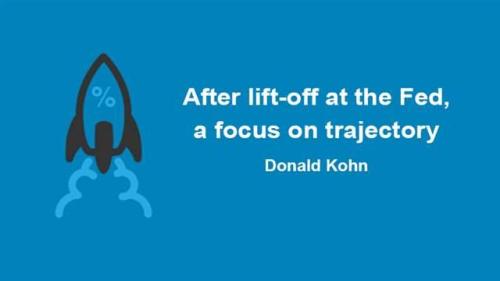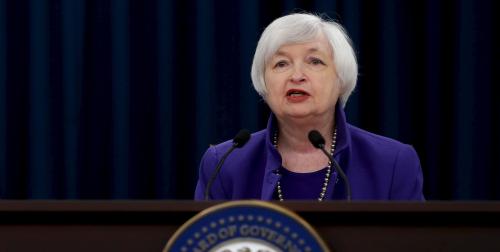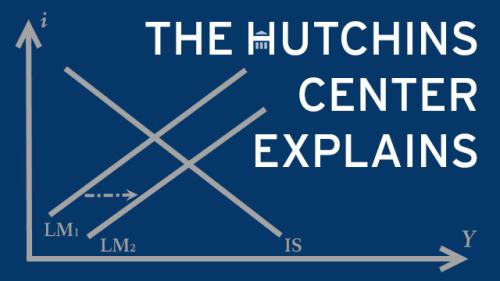A year ago, in December 2015, the Federal Open Market Committee (FOMC) of the Federal Reserve voted to lift its policy rate by one-quarter percentage point after keeping that rate close zero for seven years as a response to the Great Recession. With the unemployment rate projected to fall further and inflation to rise gradually over 2016, the question was how far that rate would need to increase this year for the FOMC to engineer a soft landing for its dual objectives of maximum employment (seen to be an unemployment rate near 4-3/4 percent) and stable prices (defined to be inflation of 2 percent.) Ultimately, the FOMC ended up raising rates just once – another quarter-percentage point – during the year.
2016 in review
In fact, the labor market and inflation behaved very close to the FOMC’s expectations in 2016. Unemployment averaged 4-3/4 percent in October and November, right in the middle of the range of projections FOMC participants made at the end of 2015. Total inflation as measured by the FOMC’s preferred metric (the Personal Consumption Expenditure chain price index) was 1.4 percent in the 12 months ended in October (latest data available) near the middle of the central tendency of the FOMC’s December 2015 projections of 1.2-1.7 percent. And the core PCE index, which the FOMC sees as better representing underlying inflation trends because it excludes volatile food and energy prices, grew 1.7 percent, at the upper end of the central tendency of FOMC projections.
Those are amazingly accurate predictions in an uncertain and imperfectly understood economic environment. But before we hand out forecasting prizes to the FOMC, we should consider the one projection they got quite wrong: their own actions. Just days ago, the FOMC announced a further rate increase—of 25 basis points to 50-75 basis points. But that was the only one this year; back in December 2015, no FOMC participant expected fewer than two rate increases this year; the vast majority expected two to four increases in 2016 (50-100 basis points); and the remainder anticipated that more than 1 percentage point of tightening would be necessary to keep the economy on track to achieve the FOMC’s objectives.
What happened? A number of developments over the year undermined the FOMC’s confidence in the anticipated progress toward their labor market and inflation objectives.
First, much of that progress did not take place until late in the year, raising questions about whether it would occur at all. The unemployment rate hovered at or just under 5 percent until November, and rising labor force participation suggested greater flexibility in the supply of labor. Inflation rose early in 2016, but then leveled out for a while somewhat below the 2 percent target before beginning to rise again in the third quarter.
Second, several developments raised questions about continuing progress toward the FOMC’s objectives. U.S. growth was quite sluggish in the first half of 2016, averaging only about 1 percent. Global growth disappointed through much of the year and its prospects were revised down, damping demand for U.S. exports and putting downward pressure on global inflation. Adding to concerns were adverse financial market adjustments early in the year, doubts about the smooth transition of the Chinese economy to reduced dependence on exports and investment, and the effect on markets and global spending of the uncertainties created by the vote in the UK to leave the EU. Although total inflation firmed in 2016, from time to time, inflation expectations in surveys of households and in measures inflation compensation derived from financial market prices showed signs of slipping below the 2 percent target.
Third, over the year, FOMC participants revised down their estimates of where the Federal funds rate would finally need to come to rest to hold the economy at full employment and stable prices (so-called r*). In December 2015, they saw that rate centered around 3-1/4 to 3-1/2 percent over the long run; by this December, the central tendency of their estimates was a full half point lower at 2-3/4 to 3 percent. The lower r* implies that any given Federal funds rate is less accommodative than had been thought and that more gradual increases will have the same restraining effect on the economy as would steeper increases with a higher r*. Moreover, FOMC participants through the year increasingly emphasized that they saw a Federal funds rate of 2 percent as high enough to balance the economy on an interim basis.
And fourth, the FOMC sees the low level of interest rates as calling for an especially cautious approach to tightening policy—for a need to be more certain than usual that any rate increase is called for. That’s because if increasing rates unexpectedly weakens the economy, raising the unemployment rate and short circuiting the climb toward the 2 percent inflation target, with rates already low, the FOMC will not have much room to reverse course and stimulate the economy and hit its inflation target. On the other hand, if the rise in rates turns out to be too slow and inflation begins to run over its target in a sustained way, the FOMC can readily execute a mid-course correction by raising rates more quickly and without limit to counter the inflation threat. Risk management when rates are near their zero lower bound suggests a more damped trajectory of tightening, at least initially, than might be the case if rates were already well above 1 or 2 percent.
Prospects for 2017
As noted, the FOMC raised rates at its December meeting. Projections of FOMC participants at that meeting once again suggested that most believe between two and four quarter-point increases in the coming year would be required to steer the economy toward the FOMC’s objectives.
The economy is much closer to the FOMC’s targets for labor markets and inflation at the end of 2016 than it was at the end of 2015, and both the FOMC members and most outside forecasters see further tightening of the labor market and increases in inflation as the most likely outcome for 2017. But monetary policy remains fairly accommodative, with the policy interest rate still more than a percentage point below the 2 percent interim estimate of r* and only a touch higher than it was at the end of last year. This configuration perhaps reinforces the likelihood that the FOMC will need to trace the projected path of FOMC participants more closely in 2017 than it did in 2016 to keep inflation from overshooting its target.
As in 2016, however, the actual trajectory will depend on developments during the year. In that regard, with a Republican president and Congress for the first time in a number of years, the odds that major changes in tax, spending, trade and regulatory policies will affect the trajectory of interest rates are much higher than in the past.
One aspect is fiscal policy, where the incoming president’s plans for tax cuts and increased spending on infrastructure and defense could imply a very substantial boost to demand at a time when the economy is already close to full employment. That in turn would require a steeper rise in rates to keep inflation contained.
The new administration is also contemplating an easing of regulations and reform of tax codes that it believes will boost incentives to innovate, invest, and otherwise increase the capacity of the economy to supply goods and services. Greater economic potential, by itself, would tend to damp inflation pressures, but it also would increase demand as businesses and households stepped up spending in anticipation of faster growth in sales and incomes, raising the interest rate that held the economy in equilibrium. Any effect on potential growth likely would be realized only gradually, so the supply side aspects of new policies might not have much effect on the appropriate path of policy next year, but could over time raise r* and the path of rates.
Finally, the incoming president has talked a lot about erecting barriers to imports from particular countries and penalizing the imports of companies that moved production from the U.S. to other countries. Reducing the openness of the U.S. economy to trade and lessening competitive pressures on U.S. companies could damp their incentives to adopt practices that would increase productivity. Any increase in tariffs and damping of productivity growth might also tend to put upward pressure on costs and on prices paid by U.S. companies and households—depending on the reaction of the dollar in foreign exchange markets. Like the structural polices, these would probably play out over some time, but they would raise tricky analytical and policy questions for the Federal Reserve as it attempts to keep aggregate demand in line with potential supply so as to meet its dual objectives for stable prices and maximum employment.
In 2017, the surprises are likely to come from different directions and have different implications than the surprises the Federal Reserve had to adjust to in 2016. But next year, like this year, will test the Fed’s ability to adjust policy to chancing economic circumstances and then to explain clearly why it made the decisions it did.









Commentary
Op-edFed rate hikes: slow in 2016; steeper trajectory in 2017?
December 20, 2016